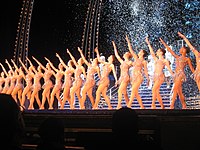
Photo from wikipedia
OBJECTIVES: The roadmap for how to approach restrictions during the COVID-19 pandemic is unclear. Many governments have acted to close bars and restricted alcohol sales, while at the same time… Click to show full abstract
OBJECTIVES: The roadmap for how to approach restrictions during the COVID-19 pandemic is unclear. Many governments have acted to close bars and restricted alcohol sales, while at the same time those in the nightlife industry have labeled such actions unfounded. Complicating such debates is the lack of direct evidence on the effect of alcohol on social distance. In the current study, we offer the first examination of alcohol's impact on social distance. Methods: Young social drinkers (N = 212) were required to identify at least one eligible same-gender friend. On the day of their laboratory sessions, participants were randomly assigned to complete experimental procedures with either their own friend or the friend of another participant (an individual who was a stranger to them). Dyads were assigned to consume a dose of alcohol (target BAC = 0.08%) or a non-alcoholic beverage. Participants' interactions during the beverage administration period were videotaped. Computer-vision algorithms were employed to pinpoint the relative position of each participant's face at regular 10-sec intervals throughout the drink period and these values were used to approximate social distance. We employed mixed models to examine within-dyad change in social distance between minutes 4-36 of the interaction. Results: Within the stranger condition, a significant interaction emerged between beverage condition and time, b = 0.22, SE = 0.11, p = 0.039. For stranger dyads assigned to consume alcohol, interpersonal distance decreased at an estimated rate of 0.26 cm/minute, b = -0.26, SE = 0.07, p < 0.001, whereas this slope was non-significant for stranger dyads assigned to consume a non-alcoholic beverage, b = -0.05, SE = 0.08, p = 0.559. Participants consuming alcohol in the current study drew significantly closer to an unfamiliar interaction partner as time passed and intoxication-level increased. Conclusions: Results suggest that alcohol might act to overcome a natural caution people feel towards strangers and promote proximity-seeking. The rate of change in distance observed in the current research is likely a conservative estimate of what might be observed in a bar environment, given participants in the current study were seated and separated by a table. Nonetheless, extended over the course of an evening, the rate of change observed here would result in social distance reductions with potentially meaningful implications for disease transmission.
Journal Title: Alcoholism: Clinical and Experimental Research
Year Published: 2021
Link to full text (if available)
Share on Social Media: Sign Up to like & get
recommendations!